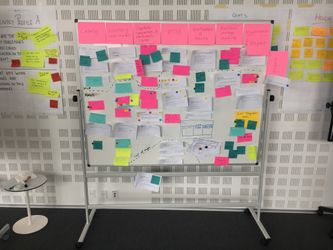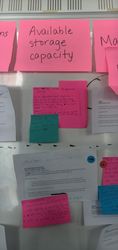...
| Topic | Notes/Presentation |
|---|---|
| Review of the MVP process and objectives for the breakout sessions by domain | See the following notes on the discussions which took place. |
| Attendees: Ryan McWhorter (UNICEF), Dorthe Konradsen (UNICEF), Teresa Ha (UNICEF), Facilitator: Brandon Bowersox-Johnson (VillageReach) Key Activities discussed
|
| Attendees: Ashra Islam (JSI), Gemma Orta-Martinez (UNICEF), Jorgen Kofoed (UNICEF), Alpha Omari (JSI) Facilitator: Chris Wright (JSI) The group discussed a wide range of user stories, key activities, and scenarios. The following is a brief summary of the two day discussion. Key Take aways: Annual national forecast needs to be entered into OpenLMIS rather than building in the various forecasting logic required, especially because there are different methodologies and sometimes mixed methods for determining forecast. But some information must also be included as text to capture the methodology used, the assumptions, and any constraints that affected the final quantity forecasted (e.g. budget limits or storage capacity). Forecast should be the true "constrained forecast" on which supply plans and forecast accuracy are based. OpenLMIS should enable upload of forecast for all levels if the program follows the traditional WHO methodology.
If the annual forecast is used to determine resupply throughout each tier of the supply chain using an allocation/push system, then pipeline views (future stock position based on forecast, current SOH, AMC, and planned resupply) are MVP must haves at each level in order to predict potential stock imbalances that risk stock out or expiry due to overstock anywhere within the system. This will inform resupply decisions (timing and quantities). If lower levels requisition, MVP functionality should provide each user a suggested resupply quantity based on: Max - (closing) SOH = qty to order. This is simple and takes into account any losses/adjustments due to transfers, expiry, damage, etc. However, this will work only if the MVP Max stock level is a dynamic figure (configuration) shown as months of stock (MOS) or weeks of stock (WOS), in which:
|
| Attendees: Mitesh (NexLeaf), Michelle (UNICEF), Matt (PATH), (Josh (VillageReach) for part of the day) Facilitator: Rachel Powers (Deactivated) (VillageReach) The group focused on the key activities:
|
| Attendees: Amy Roberts (CHAI), Justin, Fesha, Kaleb Brownlow (Gates Foundation) Facilitator: Vidya Sampath (VillageReach) The group focused on the key activities:
|
| VillageReach reviewed the activities and stories within each domain. An initial line of the MVP was drawn. |
...







